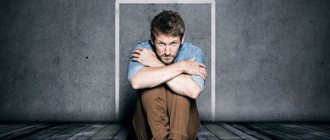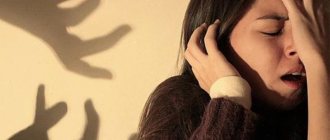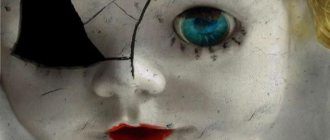Crowd fear is a persistent and negative mental reaction to a large crowd of people. Pathological fear manifests itself in the form of panic attacks, which are accompanied by an attack of dizziness, surges in blood pressure, suffocation and loss of consciousness. According to experts, this disorder occurs in childhood, due to the influence of traumatic factors. Let's learn about how this disease manifests itself and talk about methods of dealing with panic attacks.
A phobia is a persistent reaction to a stimulus that a person experiences as negative.
General information
Have you ever wondered what the fear of people is called?
Back in 1910 Chudinov A.N. used the term anthropophobia . ICD-10 code – F40.1 Social phobias. This is a type of social phobia that causes negative reactions and panic states during communication, contact, the presence in life of such objects of fear as a person or group of people of a certain profession, social status, or regardless of the type of detail, age and other characteristics of individuals.
Manifestations of phobic disorder
A phobia, manifested in the form of panic fear of a large crowd of people, has a protective nature. Fear of visiting public places has certain reasons for its occurrence. Among the rational reasons for fear of visiting crowded places, one should highlight negative life experiences and the individual characteristics of a particular person. Extreme situations, war, riots and other negative social conditions can significantly increase the risk of the disorder.
According to psychologists, it is very important to be able to separate irrational and rational fears. The reasons for the occurrence of the latter can be explained, since they are associated with the presence of real sources of threat. Let's imagine a situation where there is a robber in the city who attacks lonely passers-by at night. A person who needs to return home at night may experience fears for his health and material values. This form of fear has real reasons for its occurrence, which are explained by the current situation. This form of fear refers to rational factors.
Now imagine a person who refuses to leave his own home because on the street he could get into a traffic accident, become a victim of a robber, get injured or have his clothes torn, which will cause ridicule from others. It is important to understand that the likelihood of similar events occurring is extremely low and most people simply do not think about such situations. This form of fear is irrational.
The main differences between the irrational and rational forms of crowd fear are:
- Rational fears have reasonable causes associated with real events.
- Irrational fears involve fear of potential threats and imaginary situations.
Demophobia also occurs as a concomitant factor in mental illness and nervous disorders.
Thus, the forms of personality disorder under consideration are a heightened instinct of self-preservation. The lack of psychological help can cause panic to transform and develop into an acute desire to constantly be in the apartment.
The development of the disorder leaves a unique imprint on both the personality itself and the behavioral model of a particular individual. The disorder can manifest itself in the form of avoidance of contacts with other people and feelings of disgust, giving rise to a desire to harm others. Also, many of the patients talk about the fear of contracting various diseases from others. At a certain stage in the development of the disease, the patient develops a distrust of people, which has a strong resemblance to attacks of paranoia. Among the physiological manifestations of panic attacks, one should highlight the appearance of shortness of breath, attacks of nausea, tremors of the limbs, increased sweating and heart rhythm disturbances.
Pathogenesis
People suffering from anthropophobia typically feel uncomfortable and stressed when interacting with others, especially strangers.
The main manifestation of the disease is voluntary social isolation, distrust and suspicion of other persons.
It all starts either with traumatic circumstances, violence, or with difficulties in establishing contact with the environment. A person begins to close himself off and realize that it is better for him to be alone, and avoids strangers. In the future, contact with others like oneself is reduced to a minimum, and in cases where interaction occurs, it becomes traumatic and causes stress .
As a result, a destructive defensive behavior pattern develops.
Causes of demophobia
The disorder in question occurs during puberty. The cause of the disease may be evidence of public shame, mass violence or an accident with a large crowd of people. Quite often, such disorders develop in people who have survived a terrorist attack.
Let's imagine a situation where a fire breaks out in a movie theater. People in the hall fall into mass panic, which causes dire consequences. A crowd of people running towards the exit can crush and fatally injure others. A person who has experienced such events may be in a state of severe shock. The human psyche is designed in such a way that, in order to avoid serious disorders, defensive reactions are triggered, one of which may be fear of public places. According to experts, this disorder is based on social causes associated with negative life experiences.
Classification
Fear of society
Fear of one's own kind ( anthropophobia , from Greek anthropos - person, phobos - fear) is one of the most severe forms of phobias, because with arachno- or aerophobia it is possible to exclude traumatic factors - spiders and flights, and with anthropophobia it is almost impossible to avoid society around the clock.
Fear of contact with any person makes the patient’s life as uncomfortable as possible. After all, we are all social beings, with our own needs and life tasks, for example, the need for self-development, reproduction, career growth. However, it should not be confused with a state where a person is afraid to perform social actions. If a person is being watched by an imaginary or actual person (group of persons), then this is already social phobia .
Fear of crowds
The fear of large crowds of people is called demophobia . Unlike anthropophobia, the patient does not experience fear when interacting with individuals; panic attacks and stress develop only in crowded places. It is much simpler and easier to cope and live with such a problem; it is enough to avoid large companies.
Fear of men
Social phobia in which males are the object of fear is called androphobia . It occurs more often in women, but there are cases where it was also diagnosed in men.
Like other psychological disorders, androphobia is treatable, but many patients are afraid to admit that they suffer from this problem. The reasons for the fear of men lie in the experience of violence, cruelty, unsuccessful first sexual experiences, and even constant unflattering statements from those around them towards men, watching films with male aggressor protagonists.
In clinical practice, there are other types of anthropophobia; there are cases when patients are afraid of people of a certain profession (for example, most often dentists and other doctors), a certain age, social status (superiors), etc.
Manifestations of fear of crowds as a phobia
Fear of crowds can manifest itself in different ways - someone is afraid of large crowds of people
(for example, the subway at rush hour, rallies or concerts, where there is an army of thousands of fans of the performer), for some, a
small filled cinema
.
Some people are most afraid of situations when it is not possible to immediately avoid the company of other people
and return to a safe place - for example, once there are other people sitting on the right and left.
At the same time, we note that some agoraphobes are frightened by deserted streets or open spaces, but such manifestations are not associated with the fear of crowds. Regardless of the specific forms, as a rule, the fear of agoraphobes is caused by the fact that they find themselves in an unsafe and uncontrollable place
, where real or imagined dangers emanating from a hostile outside world come to life.
Many are frightened by their own potential helplessness,
both in principle in such an environment and specifically during an attack of phobia.
Someone places too much importance on how others react to a panic attack.
- Agoraphobes are afraid of being ridiculed or despised, as well as that someone will take advantage of their condition and, for example, rob them. All this only encourages panic. One of the extreme forms of agoraphobia is when a person, avoiding situations that cause attacks of fear, begins to perceive everything that is outside the home as a source of danger and completely stops leaving his “shelter”.
Causes
Fear of people is a phobia, but like other problems of a psychological nature, it arises at an early age, namely in adolescence, when the psyche is most unstable and unformed, regardless of gender.
Among the main reasons are:
- low self-esteem and individual failures;
- fear of criticism and the risk of embarrassment;
- chronic psychotraumatic effects (for example, overly strict upbringing);
- physical, sexual or mental violence.
However, there are cases where fear of people also occurred in adults after experiencing an extreme traumatic event.
Phobia or just fear of large crowds?
As a final note, it's completely normal to feel nervous when you're surrounded by a lot of people. Many people don’t like it when someone else touches them, even when these touches are forced - in a crowded elevator or carriage. Many people are afraid that a pickpocket will take out their phone or wallet in the subway or on a crowded street - this fear, like some others associated with the danger of being in a crowd, cannot be called irrational. Panic attacks caused by these potential dangers are irrational
.
Fear of crowds is most common in big cities (which is quite logical), and if it has overtaken you, it is better not to self-medicate or simply ignore crowded places
(you won't be able to do this all the time). Contact a specialist and he will help you get rid of the fear of heat, no matter what name you prefer for it - demophobia, ochlophobia, agoraphobia. Fortunately, in most cases it is not as difficult as working with some other types of phobias.
You can find a specialist who can help with this problem on ZIGMUND.ONLINE. There is a special offer for our readers: with promo code EXPSY
the first two lessons will cost a total of 2190 rubles
Symptoms
Fear of strangers when interacting with objects of fear is accompanied by:
- experiencing negative emotions (anxiety, anger, concern for one’s own safety);
- development of severe vegetative reactions ( tremor , vomiting , hyperemia , profuse sweating , involuntary urination and defecation, etc.)
Anthropophobia in a person causes the development of compulsive behavior - actions that are defensive in nature and repeated in similar situations to prevent their development, for example:
- walking from corner to corner;
- muttering and talking to oneself;
- involuntary chaotic body movements;
- repeated hand washing;
- unbridled appetite and, as a result, stress eating.
Demophobia: how to determine if people are afraid
You can overcome the fear of crowds once and for all by diagnosing the symptom in a timely manner. Making a diagnosis is only within the competence of a psychiatrist (since this may be only one of the symptoms of other disorders - schizophrenia, dementia or psychosis). The specialist conducts a comprehensive diagnosis, which includes anamnesis - collecting information about the patient’s childhood, conditions of personality development, work, residence and social environment.
The anamnesis contains both subjective and objective information:
- information from the patient himself about the course of the disease, when its signs first appeared and what events preceded it. It is worth paying attention to memories of childhood and family, facts of abuse of mind-altering substances. Information about past illnesses, injuries and infections is taken into account;
- An anamnesis about the disease is collected from the client’s friends and relatives: when and under what conditions it appeared. It is important to obtain information from parents about developmental features in childhood.
Close people of a person suffering from fear of crowds are asked the same questions as a demophobe. It is important to identify discrepancies in answers, find out what facts the client kept silent about and what life events he imagined in a different light.
To make a correct diagnosis, a psychotherapist or psychiatrist uses the following method:
- rating scales and special questionnaires;
- observing the patient's behavior and speech patterns.
Don't let anxiety turn into a phobia!
Be attentive to yourself and analyze your own condition. Awareness of the “here and now” is important in the fight against anxiety and excessive impressionability. If you have discovered one or more symptoms of demophobia, do not draw premature conclusions. You can overcome increased anxiety on your own, without a psychologist or psychotherapist.
To do this, use the following recommendations:
- When you feel approaching anxiety, look around you for potential danger from those around you. After a few seconds, you will notice that everyone is busy only with their own thoughts and affairs. For them, you are the same ordinary background as the rest of the passers-by;
- The voice of a familiar person whom you trust has a calming effect in many cases. Call your mother, sister or old friend on the phone - this way you will be distracted, gain more strength and confidence;
- a person in a restless state does not see people like himself in a crowd. To him, everyone seems like a faceless gray mass. Talk to someone in the crowd, ask any question like “what time is it?” or “where is the street...?” Having received a calm, adequate answer, you will be able to assess the situation more adequately, make sure that there is no reason to panic;
- try to feel yourself, your physical body. Pay attention to your breathing: it should be deep and even. Psychotherapists recommend focusing on your breathing in order to quickly relax, organize your thoughts and relieve an acute condition. To learn breathing practices perfectly, you may need to repeat them several times.
Treatment with folk remedies
There are several ways to strengthen the nervous system, achieve a sedative effect, and reduce nervousness and anxiety using medicinal plants and vegetable root vegetables:
- eat 200 g of carrots every day or drink a glass of freshly squeezed carrot juice;
- use 1 tbsp. infusion of aster chamomile, hawthorn or valerian 3-4 times a day (1 tablespoon of raw material is enough for a glass of boiling water);
- 1 teaspoon of tincture or ginseng root or leaves steamed in a glass of water (proportion 1:10);
- consume 100 ml of decoction of mint leaves in the morning and evening (1 tbsp mint per 200 ml of boiling water, which must be boiled for 10 minutes);
- 3 times a day, 30 minutes before meals, drink herbal tea with lemon balm leaves or 30-40 drops of motherwort juice .
Treatment methods
It is important to pay attention to the fact that carriers of this phobia need the help of an experienced psychologist. An attempt at self-medication can only aggravate the situation and cause complications . In the first stages of therapy, it is very important to correctly diagnose the disorder and identify the causes of its occurrence. Drug treatment involves the use of mild antidepressants in combination with drugs that reduce anxiety.
Psychotherapeutic correction involves the use of cognitive behavioral therapy and desensitization methods. The success of therapy depends on the severity of the disorder, the individual characteristics of the patient’s psyche and the correctness of the prescribed treatment.
In children
Social phobias have a more erased, variable nature; with age, the picture becomes more typical and clinically more defined. With anthropophobia in children, in most cases, motor disinhibition predominates, manifesting itself in the form of behavioral changes and decreased academic performance. The child’s emotional experiences affect the activity of internal organs and systems. Children also tend to focus heavily on a conflict situation, which easily leads to the emergence of fears.
Treatment and prognosis for children are more optimistic than for older people.
Causes of ochlophobia
According to scientific researchers, the main cause of this disorder is heredity. The presence of such diseases in one of the blood relatives significantly increases the risk of pathology in the child. According to statistics, approximately sixty percent of ochlophobes have close relatives with the same diagnosis.
An important role in this issue is played by upbringing and family values. Many parents, without thinking about the consequences of their actions, unconsciously plant various fears in the child’s mind. Excessive care, attempts at intimidation and a critical attitude can cause the disease . The influence of biological factors should also be taken into account. According to scientists, congenital pathologies of the central nervous system are closely related to the emergence of various fears. This phenomenon is called “behavioral inhibition.” Despite the fact that it does not belong to the category of pathologies, there is a high probability of fear of strangers.
As a rule, the prerequisites that give rise to demophobia are laid in childhood, when personal space is formed
Psychologists say that one should look for the reasons for the development of phobic disorders in negative social experiences . Psychotraumatic circumstances significantly increase the risk of various personality disorders. Fear of large crowds has a high level of comorbidity. Ochlophobia and demophobia are associated with diseases such as autism, attention deficit disorder and depression, alcoholism, bipolar disorder and post-traumatic stress disorder.
It is important to note that crowd fear is not the primary violation in all cases. This symptom may indicate the development of more dominant diseases, including schizophrenia, Asperger's syndrome, identity disorder and autism.
At-risk groups
Children from disadvantaged families are at risk: those who were constantly belittled and discriminated against. As a rule, we are talking about authoritarian or overprotective upbringing. In both cases, parents suppress the child’s personality, prohibit self-expression, and violate boundaries.
Sensitive people with an introverted personality type are also at risk. At the same time, demophobia can develop in any person who has been injured in a crowd, for example, after an attack or robbery.
The main features of ochlophobes (demophobes): distrust of the world, anxiety, suspiciousness, self-doubt, low self-esteem, dependence on other people's opinions.
Demophobia
Demophobia is a narrower concept that means fear of large crowds of people (in the subway, in lines at a store, at rallies, and so on). Some are so afraid of being among a crowd that they experience a panic attack just imagining themselves in it or just watching it. A demophobe, like many people who are subject to a variety of fears, strives to avoid any situations that could awaken his panic. However, for him there are fewer such situations than for those suffering from agoraphobia.
How to get rid of fear of crowds
Any phobic disorder can be treated with psychotherapy. If the fear is not too strong and the patient is well aware of its causes, then he can try to cope with the phobia on his own.
In severe cases, drug treatment is additionally used. Medicines (tranquilizers, sedatives, antipsychotics, antidepressants) do not cure anything. But at first they help the sufferer to stop panic attacks, autonomic lability and gradually overcome their fears.
People suffering from phobias find it much easier to cope with the disorder if they have the support of loved ones. For many, the problem is precisely the lack of understanding of others and the lack of empathy.
If demophobia is left untreated, the quality of life deteriorates significantly. Due to fears, the unfortunate person develops vegetative crises, his health deteriorates, and problems with loved ones begin.
Psychotherapy
A psychotherapist helps the sufferer understand and work through the causes of the phobia. Even if a destructive reaction was formed in childhood and the trigger has long been forgotten, hypnotherapy allows you to remember traumatic situations.
The most effective psychotherapeutic techniques in the treatment of phobias are:
- Gestalt therapy;
- cognitive behavioral therapy;
- hypnotherapy.
The patient, together with the specialist, gradually eliminates irrational fears from the subconscious.
The methods used by psychotherapists are very different. The specialist selects them depending on the individual characteristics of the patient.
For example, the modeling technique turns out to be quite effective. Thus, the psychotherapist, having found out from the patient details about the states he is experiencing and having analyzed them, artificially simulates various situations with him, without leaving the walls of the office.
This method allows the patient to review and analyze his reaction to the object of phobia and gradually develop new forms of reflexive behavior.
Online appointment with a psychotherapist
Diagnosis of demophobia
There are no specific methods or tests for diagnosis. The psychologist analyzes the client's complaints and observes his reactions. The specialist looks for the clinical triad of any phobia:
- irrational anxiety that intensifies upon contact with the object of fear;
- somatic reactions in response to anxiety;
- avoidance and escape reactions.
You yourself may suspect the presence of demophobia if you understand that fear controls you, and not you control it. How to distinguish personality traits from pathology? If you simply love solitude, then the crowd does not frighten or irritate you, you simply refuse mass celebrations and visits to public places. If crowds of people irritate you, you get angry, criticize people, are disdainful and are ready to show aggression, then this is a pathology.
If you do not accept rational arguments about the safety of the situation, change your life to suit fear, and avoid people, then this is demophobia.
Symptoms of a phobia
The general symptoms of phobias depend on the individual sensitivity and stability of the individual. The earlier the repressed fear manifests itself, the stronger its symptoms. In early childhood, demophobia resembles epileptic attacks. The child becomes hysterical, aggressive and uncontrollable.
During an attack, the victim’s hands shake, pulse and breathing quicken. The patient is literally “pounding”, shaking, and is unable to control his own body. Hand tremors and confusion are common symptoms of demophobia.
Treatment of demophobia
To overcome their fear, a person with demophobia does not have enough willpower or taking sedatives. To get rid of the disease, he needs the support of a psychotherapist. A competent specialist not only helps a demophobe learn to control panic attacks, but is also able to eliminate the causes of fear of large crowded crowds. In this case, it is important to contact a competent and experienced doctor who knows basic psychotherapeutic techniques.
Specialists, founded in 1989 in Moscow, use psychoanalysis, rational behavioral, rational and gestalt therapy to treat demophobia. Hypnosuggestive techniques, neurolinguistic programming, and other areas of psychotherapy may be suitable for some people. In each case, the most appropriate treatment regimen for fear of crowds of different people is selected. Many demophobes can feel relief after the first therapy sessions.
To sign up, call the administrator at the numbers listed at the top of the page, or use the feedback form.











